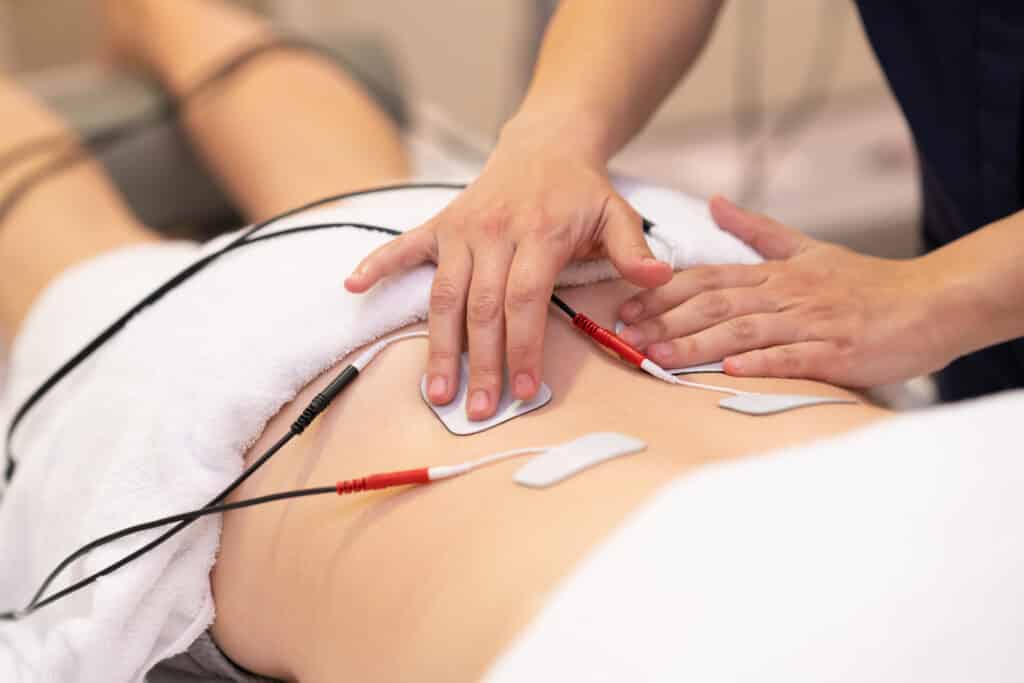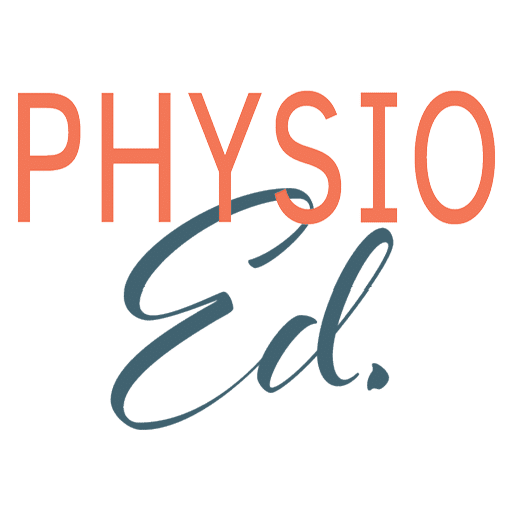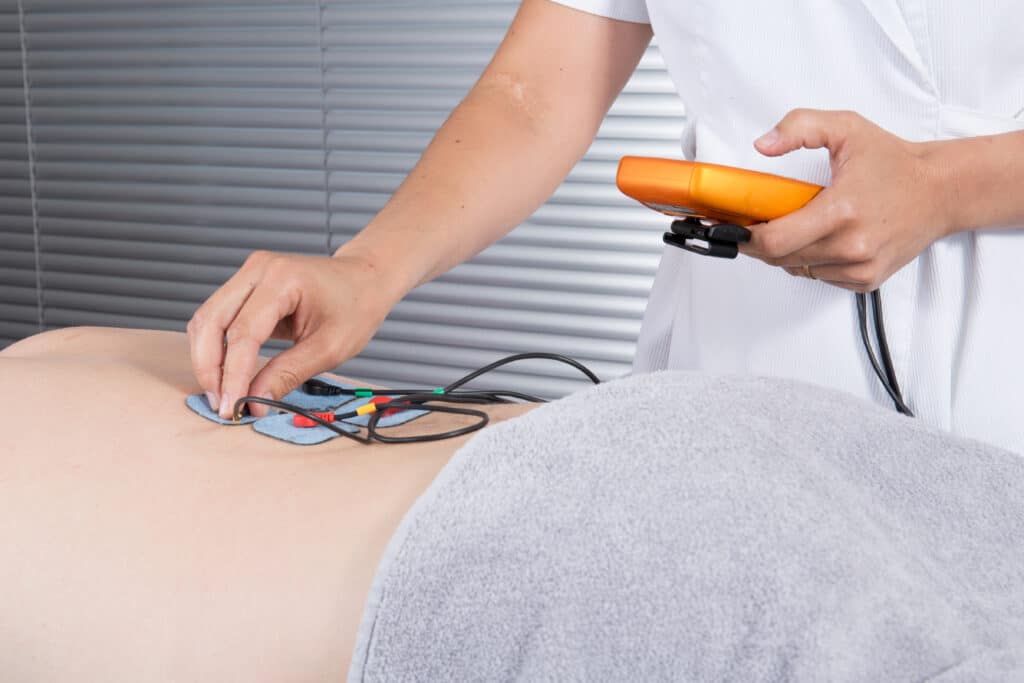For many adults, back pain can be a frustrating obstacle to enjoying new activities and hobbies. While there are several methods to manage low back pain, such as exercises, stretches, massage, and heat or cold therapy, one lesser-known technique can provide relief. Transcutaneous Electrical Nerve Stimulation (TENS) might be the ally you need to combat back pain.
When I mention electrical stimulation to my patients as part of their lower back pain treatment plan, they often get nervous and ask if I’m going to shock them. However, TENS units are designed to decrease pain, not cause discomfort.
So, let’s dive deep into the world of TENS units and discover how this unassuming device can become your new ally in regaining your mobility and combating discomfort.
Understanding Lower Back Pain
Before we explore the magic of TENS units, let’s take a moment to understand the root of lower back pain.
As we age, our bodies go through various changes and challenges. Recent studies have shown that lower back pain is common for older adults and is often caused by age-related structural changes and underlying medical conditions (1).
Back pain is an uncomfortable reminder that our naturally resilient bodies also require care and attention to stay pain-free over time.
Our muscles may become more vulnerable to strain as we age due to decreased elasticity and flexibility. Sudden movements, lifting heavy objects, and even postural changes can strain the muscles in your lower back. Some common causes of low back pain include muscle strain, degenerative disc disease, osteoarthritis, spinal stenosis, poor posture, obesity, and inactivity.
- Degenerative disc disease occurs when the discs between your vertebrae wear down, leading to localized pain.
- Osteoarthritis, a common condition in older adults, can affect the joints in your spine and cause chronic back pain.
- Spinal stenosis is the narrowing of spaces within the spine due to ligament thickening and bone spurs, which can pressure spinal nerves.
The Role of Posture and Activity
Maintaining proper posture is crucial for spinal health. Prolonged periods of slouching or sitting in a hunched position can strain your back muscles and lead to discomfort over time. Carrying excess weight, especially around the abdomen, can also increase stress on the lower back.
A sedentary lifestyle can weaken the muscles supporting your spine and make you more prone to back pain. Regular physical activity is essential for maintaining back health and preventing discomfort.
It’s important to remember that your spine is strong and built to support you. Don’t be afraid of movement when you have low back pain, as sedentary behavior can often worsen the severity of your symptoms.
Improving the way you move can help you maintain your routines, habits, and lifestyle, but with better form. By improving your body mechanics, you can move better for longer.
Now that we understand the causes and challenges of lower back pain let’s explore how a TENS unit can provide relief and improve your quality of life.
The Basics of the TENS Unit

A TENS unit is a small, portable device that uses electrical currents to stimulate nerves and reduce pain. Electrodes are placed on your skin near the area of pain. These electrodes deliver electrical impulses that help to disrupt the pain signals traveling to your brain, providing temporary relief.
How Does a TENS Unit Work?
The science behind TENS units lies in the gate control theory of pain. According to this theory, when the electrical impulses from the TENS unit are applied to your skin, they stimulate the sensory nerves, effectively closing the “gate” that allows pain signals to reach your brain.
This gate-closing mechanism helps decrease pain perception to provide much-needed relief.
Additionally, TENS units can stimulate the production of endorphins—natural pain-relieving chemicals your body produces. These endorphins can further alleviate discomfort and promote a sense of well-being.
Using a TENS Unit for Back Pain Relief
Using a TENS unit for back pain relief is a straightforward process. Here’s a step-by-step guide to help you get started:
- Consult with your healthcare provider first: Before using a TENS unit, it’s essential to consult with your healthcare provider to ensure it’s safe for you and to receive proper guidance on its usage.
- Clean the area of your back where you plan to place the electrodes. Ensure your skin is dry and free of any lotions or oils that may interfere with the electrode’s adhesive.
- Attach the electrodes to your skin, following the instructions provided with your TENS unit. Place them near the area of pain, ensuring they are securely attached.
- Turn on your TENS unit and adjust the settings according to your comfort level. Start with a low intensity and gradually increase it until you feel a tingling sensation without any discomfort.
- Follow the instructions provided with your TENS unit for the recommended duration and frequency of use. Typically, sessions can last anywhere from 15 to 60 minutes, and you can use the TENS unit multiple times per day as needed.
- Monitor your response: Pay attention to how your body responds to the TENS unit. If you experience discomfort or adverse effects, stop using it and consult your healthcare provider.
It’s important to note that while TENS units can provide temporary relief from back pain, they do not address the underlying causes. Therefore, it’s essential to combine TENS therapy with other treatments, such as exercises, stretches, and lifestyle modifications, to achieve long-term relief and prevent future episodes of back pain.
Best Practices for Using Your TENS Unit
Following the guidelines for using a TENS Unit based on expert recommendations can help you make the most of this pain management tool. However, there are a handful of best practices you can refer to when using your device at home.
Duration of Your TENS Sessions
When you first start using a TENS unit, it’s recommended to begin with shorter sessions to assess your body’s response and comfort level. Starting with sessions of around 15 to 20 minutes can be a prudent approach. During this time, you can gauge how your body reacts to the electrical stimulation and whether you experience adverse effects.
As your body becomes accustomed to the sensation, you can gradually increase the duration of each session. Experts often suggest adding 5 to 10 minutes to your session time every few days or as your healthcare provider recommends.
This gradual increase allows your body to adapt and maximize the benefits of TENS therapy.
Note Your Body’s Response & Take Breaks
It’s important to note that individual responses to TENS therapy can vary. Some individuals may find relief with shorter sessions, while others may benefit from longer periods of use. Pay attention to how your body responds and adjust the duration accordingly. Listen to your body’s cues and prioritize comfort.
While TENS therapy can be beneficial, it isn’t recommended for extended periods without breaks. Overuse can lead to skin irritation or desensitization to the electrical pulses.
Taking breaks of several days between sessions is advisable to give your skin and nerves a chance to rest. It is also imperative to check the skin around the TENS area for any signs of prolonged redness, irritation, or burns and immediately cease use if any signs of skin damage occur.
When to Avoid Using a TENS Unit for Lower Back Pain

Consulting a healthcare provider, preferably a physical therapist, is essential when considering TENS therapy for pain management. They can provide personalized guidance based on your medical history, condition, and needs. It is crucial to work together to determine the appropriate duration of TENS sessions and ensure the safe and effective use of the device.
While TENS can be effective for many individuals, there are certain situations in which its use is not recommended. These contraindications are specific circumstances or medical conditions in which TENS should be avoided to prevent potential harm or adverse effects.
Awareness of these contraindications is crucial to ensure your safety and well-being.
Implanted Medical Devices
Suppose you have implanted medical devices such as pacemakers, defibrillators, or pumps. In that case, avoiding using a TENS unit without consulting your healthcare provider is essential. The electrical stimulation from the TENS unit could interfere with the proper functioning of these devices.
Discussing the safe use of TENS therapy with your healthcare provider is essential to ensure the effectiveness and safety of both the TENS unit and the implanted device.
Epilepsy or Seizure Disorders
Individuals with a history of epilepsy or seizure disorders should avoid TENS therapy. The electrical stimulation from the TENS unit could potentially trigger seizures or interfere with medications used to manage these conditions.
If you have epilepsy, ask your physical therapist about alternative treatments for back pain.
Open Wounds or Skin Irritations
It is crucial to ensure that the skin is intact and healthy before TENS therapy to avoid potential complications.
TENS should not be applied to areas with open wounds, cuts, or skin irritations. The electrical stimulation could delay the natural healing process or cause discomfort.
Areas of Reduced Sensation
If you have areas of reduced sensation due to nerve damage or other medical conditions, using a TENS unit in these areas should be approached with caution.
Reduced sensation may prevent you from accurately gauging the intensity of the stimulation, increasing the risk of injury.
Cancer or Tumors
Individuals with certain types of cancer or tumors should avoid using a TENS unit over or near the affected area. The electrical stimulation could potentially promote the growth or spread of cancer cells.
As with many other potential complications from a cancer diagnosis, discuss any new treatment with your doctor to remain compliant with your treatment program.
Cardiac Arrhythmias
Those with severe or irregular cardiac arrhythmias should avoid TENS therapy. Electrical stimulation could exacerbate these conditions.
Prioritizing cardiovascular health and safety takes precedence for any cardiac arrhythmia diagnosis.
Allergic Reactions
Individuals with a known sensitivity to adhesives or materials used in TENS electrode pads may experience skin irritation or allergic reactions. It’s best to be aware of any allergies or sensitivities and choose TENS electrode pads that are compatible with your skin.
If you experience any adverse reactions, it is advisable to discontinue use and report the reaction to your doctor as part of your medical record.
Awareness of these contraindications allows you to navigate the TENS therapy experience safely and effectively. Remember, in all cases, your healthcare provider is your best resource for personalized guidance and support throughout your pain management journey.
Key Takeaways
- Lower back pain is common for older adults, caused by various factors such as muscle strains, age-related changes, and medical conditions.
- A TENS unit (Transcutaneous Electrical Nerve Stimulation) is a device that uses electrical pulses to provide relief from back pain.
- TENS units stimulate nerves and trigger the body’s natural pain-relieving mechanisms.
- Using a TENS unit involves attaching adhesive pads to the lower back and adjusting the settings to your preference.
- Start with shorter sessions and gradually increase the duration as your body adapts to the electrical stimulation.
- Individual responses to TENS therapy can vary, so pay attention to your body’s cues and adjust accordingly.
- Consult a healthcare provider, preferably a physical therapist, before using a TENS unit to ensure its safe and effective use.
- There are certain situations, such as having implanted medical devices, pregnancy, epilepsy, open wounds, reduced sensation, cancer or tumors, cardiac arrhythmias, or allergies, where TENS therapy should be avoided.
References
- Brosseau, L., Milne, S., Robinson, V., Marchand, S., Shea, B., Wells, G., & Tugwell, P. (2002). Efficacy of the transcutaneous electrical nerve stimulation for the treatment of chronic low back pain: a meta-analysis. Spine, 27(6), 596–603. https://doi.org/10.1097/00007632-200203150-00007
- Rojhani-Shirazi, Z., & Rezaeian, T. (2015). The effects of Transcutaneous Electrical Nerve Stimulation on postural control in patients with chronic low back pain. Journal of medicine and life, 8(Spec Iss 2), 19–27.
- National Center for Complementary and Integrative Health. (2019). Pain: Considering Complementary Approaches. Retrieved from https://files.nccih.nih.gov/s3fs-public/Pain-eBook-2019_06_508.pdf.






